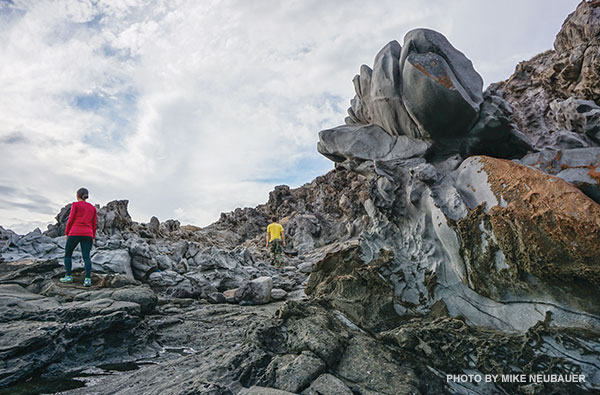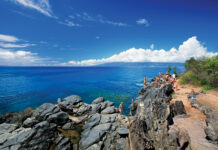Story by Lehia Apana | Photography by Mike Neubauer
I’m at Kepaniwai Heritage Gardens in ‘Iao Valley and twenty minutes into a treasure hunt that has literally led me in circles and through cobwebs. I’ve walked backwards, retraced my steps, and overturned enough stones to consider this expedition my cardio for the day. The only thing I’ve found so far is a lone rubber slipper — not the treasure I’m after.
I grip my iPhone and raise it just inches from my face. With each step, I wait as a virtual compass needle swings from side to side, using GPS technology to announce my exact mathematical spot on Earth. Twenty minutes becomes forty-five, and I head home in defeat. This is my introduction to geocaching, and it’s not going as planned.
When I told my boyfriend, Brad, that I was researching a story about geocaching, he had looked at me as though I’d ask him to explain the theory of relativity.

“Geo what?” he asked.
“It’s like a high-tech treasure hunt,” I had explained.
But to truly understand geocaching, we must rewind fifteen years — May 3, 2000, to be exact. That day, President Bill Clinton released satellite technology previously reserved for the military and private companies. Overnight, this fiercely guarded intelligence device was open to the public. Now, said the White House, anyone could “precisely pinpoint their location or the location of items . . . left behind for later recovery.”
The next day, David Ulmer, a computer consultant and GPS enthusiast in Oregon, put the technology to the test. He hid a container filled with “goodies for finders” — software, videos, books, food, money, and a slingshot — in the woods near his home, then published its coordinates online. Within days, two people found the stash and posted about their experience. News and curiosity of this budding hobby spread like Internet wildfire.
Among its earliest adopters was Jeremy Irish, who discovered his first geocache in July 2000, prompting him to start Geocaching.com. Today, the website has attracted more than 6 million registered users.
With more than 2.5 million geocaches tucked into every corner of this planet, you can likely step out the door and start searching right now. In fact, the possibilities are literally out of this world: the game’s most elusive geocache is inside the International Space Station. If interplanetary exploration isn’t your thing, you could hunt for a geocache near a shipwreck at the bottom of Lake Michigan, inside a toilet-seat museum in San Antonio, or atop Mount Everest. On Maui, geocaches leave virtual breadcrumbs leading to tide pools, petroglyphs, and waterfalls set well off the beaten path.





